Finding good strategic games—that aren’t boring—can be a tall order for those that find themselves somewhere in the middle of wanting challenging and fun games, and HATING the boring atmosphere that often accompanies complexity in board games. That’s where this list becomes very useful.
Make sure to check out our full list of awesome strategic games here. As good as this list is, we definitely couldn’t include them all on this list.
So what are the 13 strategic board games that aren’t boring?
- 5 Tribes
- 7 Wonders
- Dominion
- Splendor
- Kingdomino
- Carcassonne
- Survive
- Colt Express
- Azul
- Small World
- Blokus
- Ticket to Ride
- Settlers of Catan
Though not all games on this list fall into the same category of complexity, none of them are extremely complicated or overly difficult to play. For those games that lie closer on the side of complexity, we will make specific mention of them.
1) Five Tribes
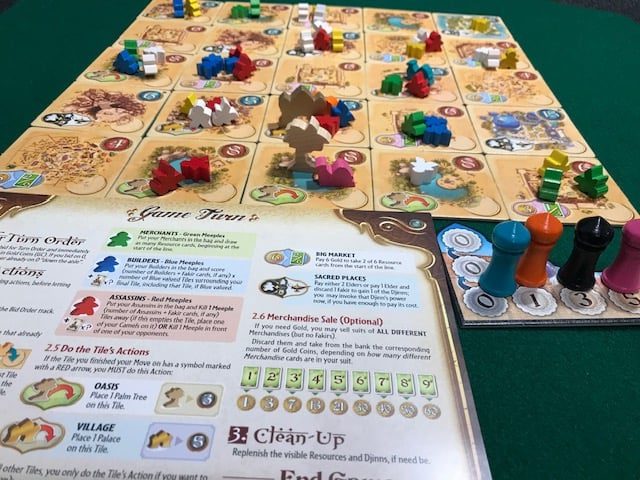
Specifics
| Players | Duration | Age | Difficulty | Type | Price | 1-10 rating |
| 2-4 | 60-80 minutes | 13+ | Medium | tile | $40 | 10 |
Game Explanation
Five Tribes is an awesome strategic game, designed for two to four players. In this game, players build a board by placing the game tiles side by side. The majority of the game plays with meeples that are placed on top of the board. The meeples come in five different colors (representing the five tribes), and three random-colored meeples are placed on each tile. Players take turns picking up meeples from various tiles and moving them around the board. Each meeple color has an associated ability that a player can use to score points—or earn the potential to score points. For example, red meeples have the ability to kill other meeples to earn points. The player with the most points at the end of the game wins.
Why it’s not boring!
Admittedly, Five Tribes is probably the most complicated game on this list. That’s why we wanted to cover it first. It takes a few minutes to not only put together how the game actually flows, but also to understand how each tribe’s (each colored meeple) ability works. But once you get that part down, it just gets really fun!
One of the major reasons this game is so great is all the options that each player can use to win. This is often referred to as “paths to victory” in a board game. It gives everyone the ability to play one strategy in a given game, and then play it completely differently the next. The more a player plays this game, the more strategies he sees available. And for all of that variation, it’s not all that complicated. It solves one of the most difficult problems with games. Usually they get exponentially more complicated as strategy and variation is added. But that’s not the case with Five Tribes!
The other thing that makes Five Tribes so great is the abilities of the various colored meeples. Each color has a unique ability that aids players in working toward victory. It’s awesome, though, how they interact with the game as a whole. For example, the player that owns the most yellow meeples at the end of the game scores 10 points per opponent that has fewer—which would be 30 points if there are four total players; however, the red meeples can assassinate the yellow meeples throughout the game. So a player can alter the scoring of yellow meeples by using red ones. This is a great example of how they all work within the game—which ultimately makes it one of the best board games ever created!
2) 7 Wonders
Specifics
| Players | Duration | Age | Difficulty | Type | Price | 1-10 Rating |
| 2-7 | 30 minutes | 10+ | Medium | Card | $40 | 9 |
Game Explanation
7 Wonders has been around for a few years now, and continues to gain popularity. In 7 Wonders, players compete for the most victory points over three rounds. In this card-based game each player is dealt a number of cards just higher than the number of players in the game. They simultaneously buy a card from their hands and pass the remaining cards to the player next to them. This process continues until each player buys one card and discards the remaining card in the middle. This process is repeated through the three rounds of play—after which, points are totaled and the winner is announced.
Why it’s not boring!
7 Wonders is fun for a lot of the same reasons as Five Tribes. The most obvious reason is that there are many paths to victory. Players can use one strategy every single time, and win; or they can look for different strategies each time they play and never really run out of options. Using some combination of the paths to victory gives endless variations. So someone looking for a strategic game that isn’t boring, should look no further than 7 Wonders.
The other prominent reason that 7 Wonders is a great strategic board game is that you can get up to 7 players in the game. Many strategic board games only allow for 2-4 or 2-5 players (one of the weaknesses of Five Tribes). Those that do allow more than that often move slowly and take way too long to play. 7 Wonders, on the other hand, allows for 7 players and still plays quickly. It seems to be mostly due to the fact that all players are taking their turns at the same time. So, by adding another player, the game doesn’t get much longer. Each player ends up taking more turns, but it’s a marginal difference and still moves quickly.
3) Dominion

Specifics
| Players | Duration | Age | Difficulty | Type | Price | 1-10 rating |
| 2-4 | 30 minutes | 13+ | Medium | Hand management | $30-$40 | 9 |
Game Explanation
Dominion is another card-based game; however, Dominion is exclusively a card game; and it’s all about collecting cards to eventually buy victory points. Players are each dealt a stack of cards—some of which are valuable metal coins. They use those coins to begin purchasing better cards that are worth more. Eventually, they reach the point where they can begin buying pretty much anything they want—which includes the most valuable of all, victory points. The game ends when the last Province card (worth 6 victory points) is taken. Points are totaled and the player with the most points wins.
Why it’s not boring!
One of the things that makes Dominion so entertaining is that there are so many card options to include in the game. Each specific game only plays with ten options for players to choose from; but the box has so many more that a group can swap in and out before they start another game. This gives endless variations to the game without adding to the complexity. Each card describes what it does. So even if it’s new to everyone, they can get up to speed quickly. And if that wasn’t enough, there are expansion packs that add additional cards with even more unique characteristics. It allows for so many variations, it’ll hurt your brain to try to calculate them.
Another awesome trait that makes Dominion great is the unique card mechanic that is taken on each turn. Players stack all the cards they’ve accumulated face down in a pile. They then draw five cards off the top and play the associated actions. Cards allow players to do things like draw more cards, buy more cards or discard a few of their cards and replace them. The way this game mechanic functions just seems to be fun for most people. They just tend to like drawing their cards and working through their pile. The better a player does at buying useful cards, the better turns they will take and the better they will fair in the game.
4) Splendor
Specifics
| Players | Duration | Age | Difficulty | Type | Price | 1-10 rating |
| 2-4 | 30 minutes | 10+ | Easy | Card, Resource | $19-$25 | 8.5 |
Game Explanation
Splendor is another game primarily made up of cards. The goal in Splendor is to be the first player to reach at least 15 points. Players can get there in a number of ways. Primarily, they will be collecting rare jewels that they will use to purchase cards. Each card has a picture of one of the rare jewels on it. They can use the jewels printed on the cards and the physical jewel tokens to buy future cards.
Some cards are even more valuable because they have a jewel and a number of victory points associated with them. Additionally, players can buy specific assortments of cards that will earn them a visit from a Noble that is worth 3 points. Once the 15-point threshold is passed by a player, all others have one more turn to attempt to score more than that. If they manage to score more, they take the win from the other players.
Why it’s not boring!
What’s so great about Splendor is that cards build on other cards, which creates serious momentum in the game. It starts out relatively slowly (though not slow enough that it’s boring!), with players mostly collecting jewel tokens to make card purchases. After a few rounds of this, players begin buying cards—which shortens the length of time it takes them to buy more cards. Before long, players are buying cards almost every round and gaining serious points. The last few rounds of the game are where most of the points are gained and when most of the nobles start showing up.
Another awesome part of the game—though less important—is the physical jewel tokens that players collect. They have a similar feel to poker chips (hopefully they don’t change that) and feel good in hand. I find myself playing with the tokens throughout the game and being entertained by those almost as much as the game itself. Obviously, this is of less consequence that what makes a game actually fun, but it certainly doesn’t hurt the feel of the game.
5) Kingdomino
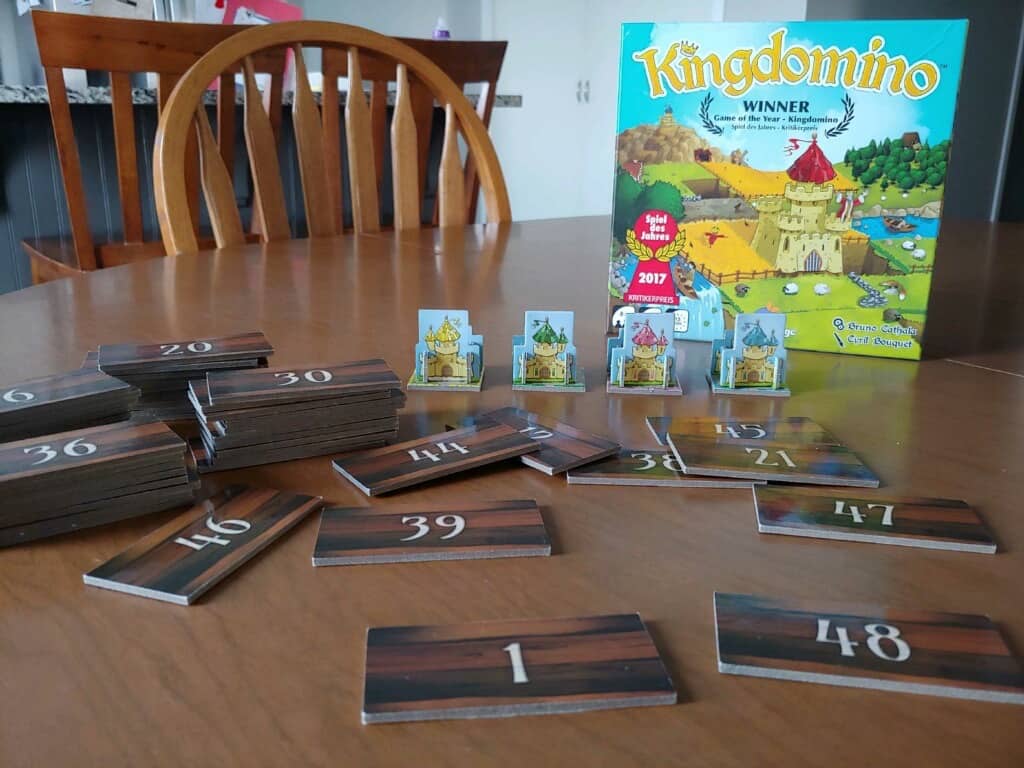
Specifics
| Players | Duration | Age | Difficulty | Type | Price | 1-10 Rating |
| 2-4 | 20 minutes | 10+ | Easy | Tile, Set | $20 | 8.5 |
Game Explanation
Kingdomino is an agriculturally themed game of building kingdoms. In this game, players collect tiles of various terrain types. They place these terrain tiles on their personal game boards throughout the game—which ends in a 5×5 grid for each player. Points are earned through connecting terrain tiles of the same type together. Terrain tiles with small crowns in the corners multiplied by the number of terrain tiles of the same terrain type total the score. The player with the most points wins.
Why it’s not boring!
I absolutely love how simple Kingdomino is without sacrificing strategy and depth in the game. It isn’t a hard game to learn, but it can be a hard game to play well. For most people, that is a great indicator for what makes a board game great. The mechanics can be learned fairly quickly, but it takes time and practice to master the finer parts of the game. It creates a challenge for players to overcome, without getting bogged down with the game process and rules. Kingdomino does this very well.
The other fantastic thing about Kingdomino is that it plays very quickly. I haven’t played a game that lasts longer than 30 minutes. And they usually don’t even last that long. If you’re playing with people that have all played before, it plays even faster still. So it’s perfect for those that enjoy strategic games that don’t want to play a game that seems to go on forever.
6) Carcassonne
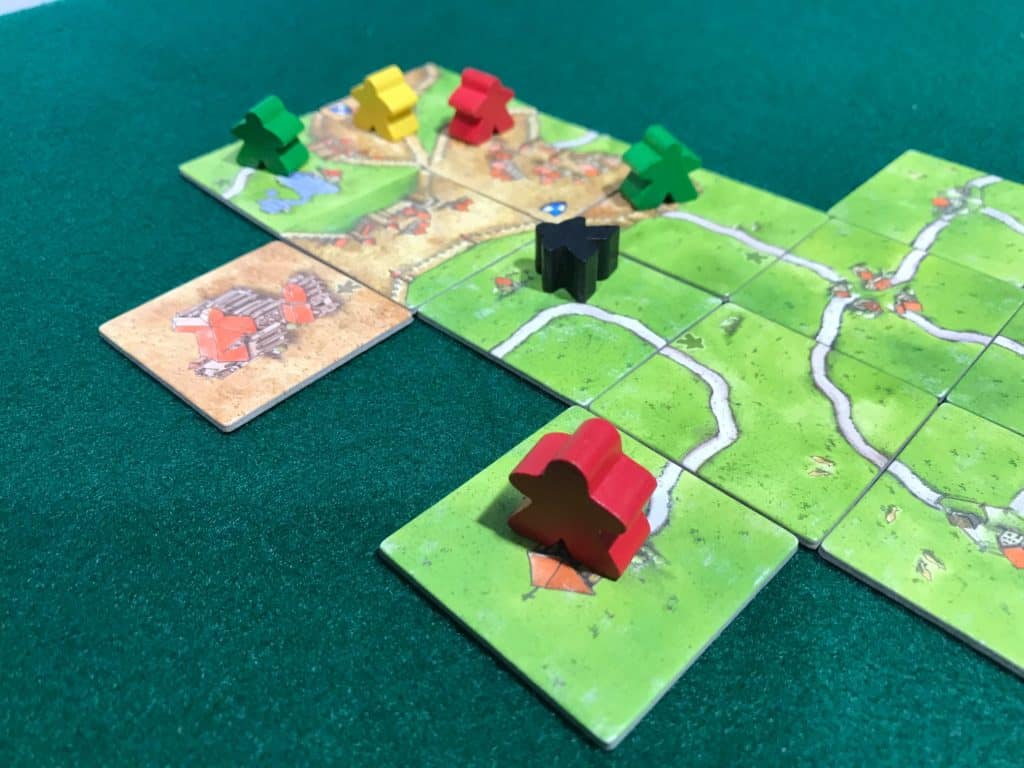
Specifics
| Players | Duration | Age | Difficulty | Type | Price | 1-10 Rating |
| 2-5 or more | 30-45 minutes | 10+ | Easy/Medium | Tile, Strategy | $30 | 10 |
Game Explanation
Carcassonne is another agriculturally themed game, but has a different feel than Kindomino. In Carcassonne, players take turns drawing and playing tiles that fit on the starting tile. The game board builds as the game progresses. Players score points by putting a meeple on a tile that creates a road, castle, monastery, or field. The player to have the most points at the end of the game wins. But be careful, crafty players can work their way into other players’ fields, roads and castles—which allows those sneaky players to collect those points too.
Why it’s not boring!
Why is Carcassonne not boring? Probably because it’s the best game ever made! While that is probably true for me, it’s a bit over the top for some people. One of the things that makes it so awesome is the endless variations of game boards that are inevitably created each game. Because players draw the tiles each turn that are used to create the board, they have the ability to play them wherever they want. And because they can play the tiles wherever they want, the board takes a unique look every time. Opportunities that are obvious in some games just don’t exist in others. Large amounts of points are scored in some games and not in others. This is all due to the ever-changing game board. It’s hard to get bored of a changing board…
Another standout in this game is the player interaction. It’s a Euro-style game, so there is no direct player interaction. By the way if you’re wondering what a Euro-style game is, we wrote a comprehensive explanation that is worth taking a look at here. However, the player interaction that does happen in Carcassonne is fantastic.
Players generally play their own game, except when a player decides to “invade” another player’s castle, road or field. There is no fighting that happens, but players can sneak their way into these places. And by doing it, they can earn points they wouldn’t have otherwise had. And if they really want to make their opponents mad, they can simply block them from completing these roads, castles and fields by placing tiles in the way.
Whatever they choose, the player interaction in Carcassonne is the perfect amount. Not so much that the object of the game is to fight other players, but just enough that more strategy is injected into the game. And if players don’t like the interaction, they can ignore it altogether.
7) Survive

Specifics
| Players | Duration | Age | Difficulty | Type | Price | 1-10 Rating |
| 2-4 | 45-60 minutes | 8+ | Easy | Dice, Adventure | $29 | 8 |
Game Explanation
Survive is an Ameritrash game (see here for the best explanation you’ve ever heard on what an Ameritrash game is) with an awesome theme! In Survive each player has a team of people trapped on a sinking island. Their goal is to get their people off the island and onto safe ground. There’s a problem, though. The resources are limited and everyone is using the same ones. Players take turns maneuvering their people onto boats and moving those boats to neighboring islands. Along the way, other players use wales to sink opponents’ boats, sharks to eat the swimming people and sea monsters to do it all in one go. The player to get the most of their people (in value not in number) off the sinking island and onto safe ground wins.
Why it’s not boring!
As in most Ameritrash-style games, Survive keeps the blood pumping with drama and excitement. Players are desperate to get all of their people off the island and onto safe ground, but there are so many obstacles in their way. There are natural occurrences that can remove a boat full of people from the game, as well as a group of opponents that would like nothing more than to do it themselves. There are also dice and unknown elements that add to the edge-of-your-seat feel to the game. So if you’re looking for a game that is exciting and dramatic, look no further.
Strategic games often don’t have dice (which are the most used way to incorporate luck into games), because dice create luck and lack of predictability. This can be a great element in a game, but it can also take away the fun for some people. If there’s luck, no amount of skill can avoid it; however, a small amount of luck can add just enough to give a player the chance to win, without taking away the fun. Survive has a die that is used every turn, but a player has plenty of ability throughout the rest of the game to win, even if luck is against him. Other players, however, then have a chance to turn the tide and win the game.
8) Colt Express
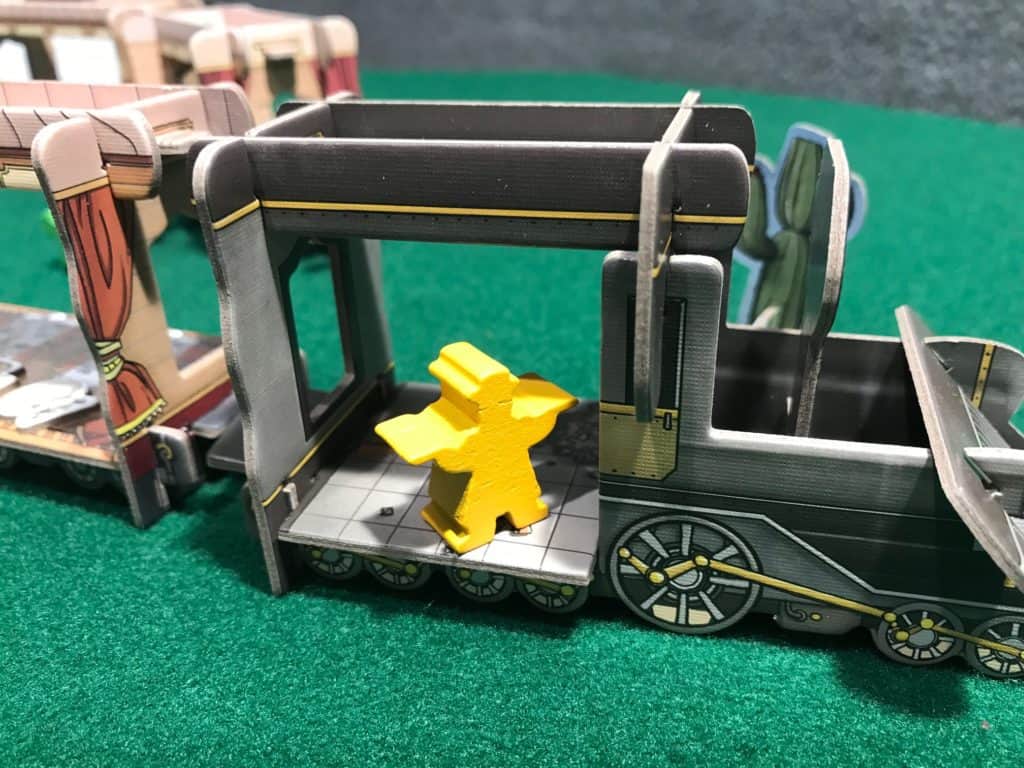
Specifics
| Players | Duration | Age | Difficulty | Type | Price | 1-10 Rating |
| 2-6 | 30-40 minutes | 10+ | Easy | Card, Train | $30-$35 | 8.5 |
Game Explanation
Colt Express is another fantastic game that you need to try! In Colt Express, players are all robbing a train in the old west. The problem is that you’re not all friends. As soon as the robbery starts, it’s every man for himself. Players take turns playing action cards into a single pile—like picking up money, shooting someone, punching someone, moving cars, or moving to the roof or down into the train. Some of the action cards can be seen by all players, while others are hidden. None of the actions are taken until all actions have been submitted—only then are the actions played out in the sequence they were submitted. The sequences are dictated by a set of cards. The player that manages to pick up and make it out with the most money through all this chaos wins.
Why it’s not boring!
There are quite a few reasons that Colt Express is so great—and therefore not boring at all! The first reason is how the actions work. As previously mentioned, players choose several actions that they will take during a given round (represented by cards submitted in the middle). Each player submits her action after another player. Once all have been submitted, the sequence begins. The first player takes his action, followed by the second, third and so on. Because they can’t see all actions, players often end up doing things like punch another player had already left the car, or attempting to pick up money that’s not there anymore. There’s no way to predict with certainty what is going to happen and where the other players will be. It makes for a really fun game.
The other fun thing about Colt Express is its theme and atmosphere. I am not usually one to care much about game themes and the “atmosphere” created by a game, but Colt Express shows how that can make a difference. The “board” is made up of a cardboard train that the game pieces actually sit inside. It takes a while to put it together when you first get it, but after that it’s perfect. It’s different than most games because you’re interacting with a three-dimensional object instead of just a board. You are moving the pieces up, down and around the board throughout the game. It’s just the right touch to take an ordinary game board and make it elite.
9) Azul
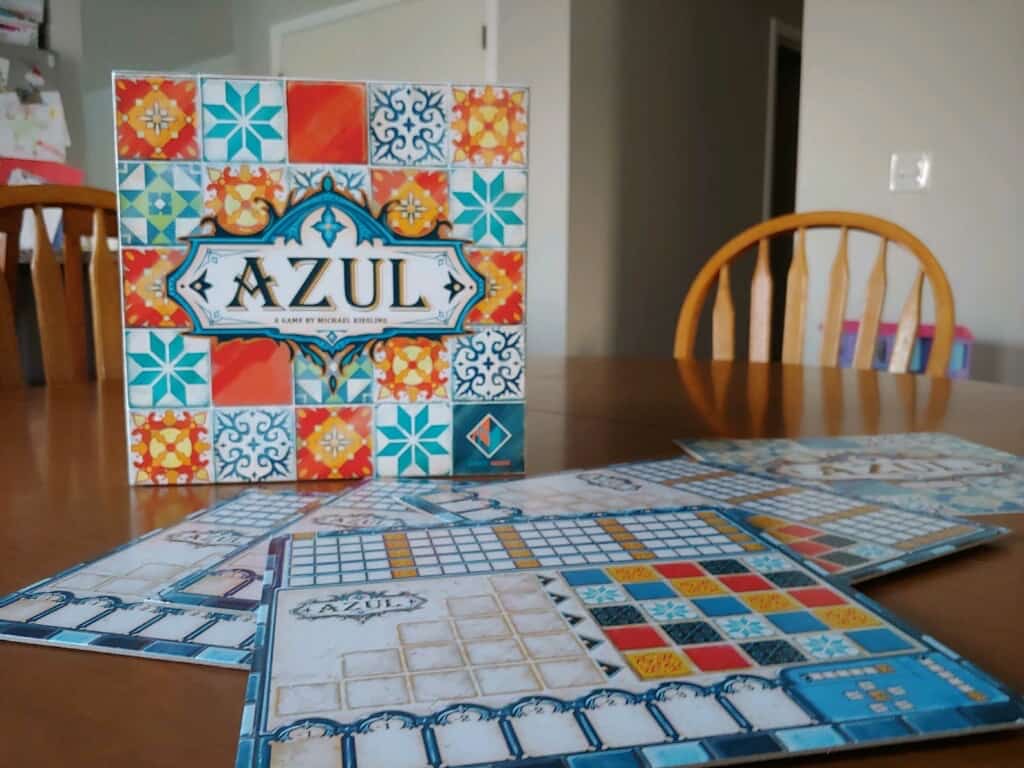
Specifics
| Players | Duration | Age | Difficulty | Type | Price | 1-10 Rating |
| 2-4 | 30-45 minutes | 10+ | Easy/Medium | Tile, Abstract | $20 | 10 |
Game Explanation
Azul is a relatively new game that won Game of the Year in 2018. It’s an abstract strategy game where players collect ornate tiles from communal piles in the middle of the table. Once chosen the tiles are moved to each player’s personal game boards—and eventually into their final resting spots that earn points. Players need to make sure they choose the right tiles because only the right numbers fit in the right spots; however, once collected and moved, players earn points based on which tiles they have and which tiles are in the right positions. The player with the most points wins.
Why it’s not boring!
Like so many other games on this list, Azul is great because it has simple mechanics but difficult execution. Players can learn the ropes very quickly. They aren’t completing difficult tasks. They are just choosing tiles and placing them on their boards. But getting good at Azul is much harder. Players need to understand which tiles to put where—and when to put them there. To complicate things further, all players are pulling from the same communal pile, so you don’t always get what you want.
The hidden reason that makes Azul awesome is that, on the outside, it looks boring. At least it did to me. I saw a few people sitting down playing it and thought I’d avoid it. I just didn’t look like a game I’d like. I thought better of it, though, because I knew it had won game of the year—so it had to be good, right? Turns out that is exactly the case. Once I played it, I was hooked! It plays so smoothly and is so fun!
10) Small World
Specifics
| Players | Duration | Age | Difficulty | Type | Price | 1-10 Rating |
| 2-5 | 40-80 minutes | 8+ | Medium | War | $35 | 8 |
Game Explanation
Small World is a unique game on this list. In Small World, players compete to occupy space on the game board that is far too small (hence the name!). Throughout the game players choose fantasy races and use them to take control of and occupy areas of the board to earn points. The more area a player controls, the more points he will accumulate throughout the game. The player to have the most points at the end of the game wins!
Why it’s not boring!
Small World has been around for a while now, and yet, it still isn’t well known. You might think that means it’s not very good, but you’d be wrong. What makes Small World so good is all the combinations of fantasy races and abilities. Like many other games on this list, Small World has the ability to play very differently each game. Because so many combinations are available, it keeps you looking for new combinations to see how they will work and how it will alter the game. I’m not usually a guy that gets into fantasy this or mystical that, but this game gets me excited each time.
Small World is not boring for another reason. I see it as a better version of Risk. Don’t get me wrong, Risk is just fine. I grew up playing—in fact, I’ve probably played it more than most people. But the more games I’ve played over the years, the less I like Risk. It’s just so bland. Games like Small World take some of the best elements of Risk and add a whole lot more fun—without most of the arguing between players. You still get the territory controlling and combat aspects that Risk has. But you add a whole extra level of richness to the game. Instead of having useless soldiers and dice, you have mystical races with special abilities that determine how the game plays.
11) Blokus
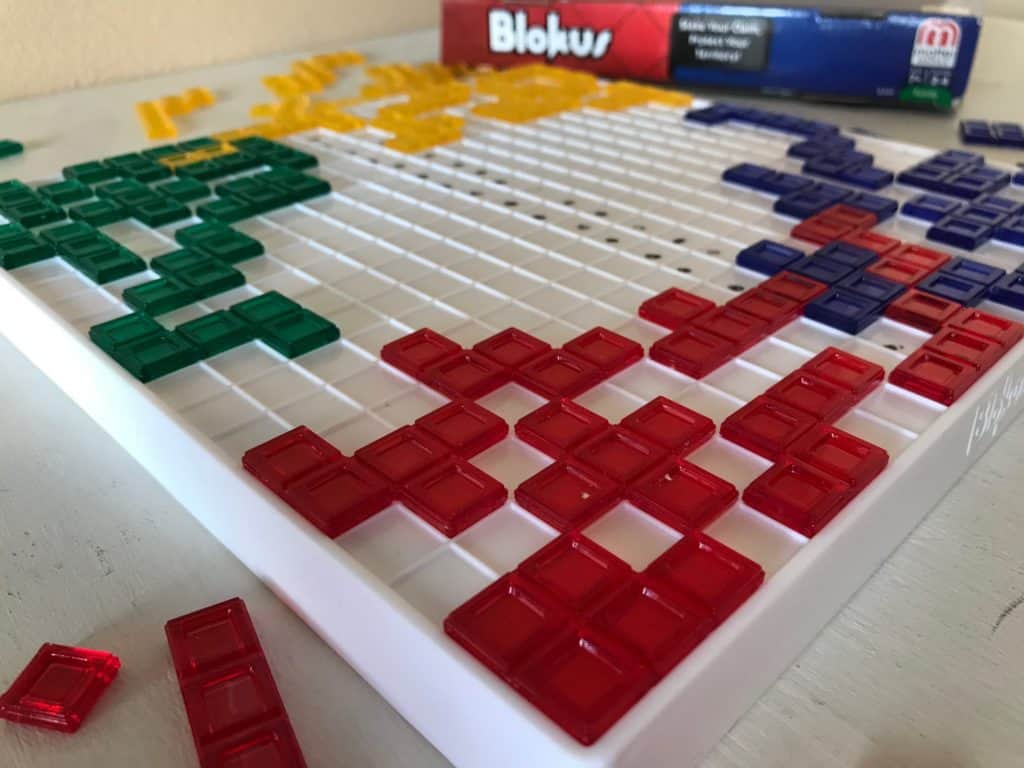
Specifics
| Players | Duration | Age | Difficulty | Type | Price | 1-10 Rating |
| 2-4 | 20 minutes | 8+ | Easy | Tile, Abstract | $20 | 8 |
Game Explanation
Blokus is an abstract strategy game best played with 4 people. In Blokus, players take turns placing odd-shaped pieces onto a small game board. Initially players play independent of one another, eventually colliding in the center of the game board. Players must connect each piece to another piece they already played—but the new piece can only touch the corner of one of their others; however, pieces can touch any side of an opponent’s pieces. There isn’t enough space on the board for all pieces to fit, so the player to have the least number of pieces off the board at the end of the game wins.
Why it’s not boring!
Blokus is another game that is more fun than it looks. Just like Azul, I didn’t want to play this game initially. In fact, I avoided it for quite a while. Finally, a few people convinced me to play while on lunch at an internship I was doing a while back. And like Azul, I loved it. I’m not sure if it’s the abstract games that don’t seem alluring, but it definitely seems to be a trend for me; regardless, when I put aside the irrational and unformed dislike of these types of games, I find that they are some of my all-time favorites. So if you’re this way, take the plunge. It’s worth it.
Now for a real reason that Blokus is great! I guess one of the best reasons I can come up with is that it’s a puzzle turned fun. I don’t know about you, but puzzles (at least the traditional ones) bore me. They are tedious and monotonous to say the least. Blokus comes along and fixes that problem. Obviously, it’s an apples to oranges comparison, but it still makes the point I was trying to get at. All players are doing an individual puzzle that interacts and becomes a battle for space. It’s competitive and puzzle-y.
12) Ticket to Ride
Specifics
| Players | Duration | Age | Difficulty | Type | Price | 1-10 Rating |
| 2-5 | 30-60 minutes | 8+ | Easy | Card | $40 | 9 |
Game Explanation
Most of us have heard of Ticket to Ride before. In Ticket to Ride players compete to earn the most points through building routes across the United States (Other countries in other versions). At the beginning of the game players receive routes they must complete or they will lose points. They can build those sections of the routes as they collect the associated colored cards during their turns. The player that has the most points by the time any player has two or fewer trains left wins.
Why it’s not boring!
One thing that makes Ticket to Ride so fun is it’s secret, objective-oriented gameplay. Obviously, all games have objectives and goals that players need to reach, otherwise there wouldn’t be a game. But Ticket to Ride feels different than most games. At the beginning, players receive cards that show them what routes they need to complete to earn points. Their whole objective is to complete those routes. Once completed (or while completing), players have to option to take more routes to earn more points.
The catch to Ticket to Ride, though, is that no one knows which routes a player is attempting to complete. They don’t know how many points each player has already or how many another player will achieve before the end of the game. To make it worse, not all routes are worth the same amount of points. As you can imagine, this causes players to be ambitious and try for more than they otherwise would—creating a fun, competitive atmosphere.
Another great thing about Ticket to Ride is that it’s a “do-your-own-thing game”. At least, for the most part. Players pretty much play their own game and build their own routes. Opponents don’t really try to impede others from accomplishing their objectives. Obviously, players can block routes to certain cities so other players can’t go there. But in real gameplay, most people just don’t do that all to often. For the most part, players can do their best without other people getting in the way. Some people don’t like this aspect of the game; but most of us find it to be a positive addition to the game.
13) Settlers of Catan
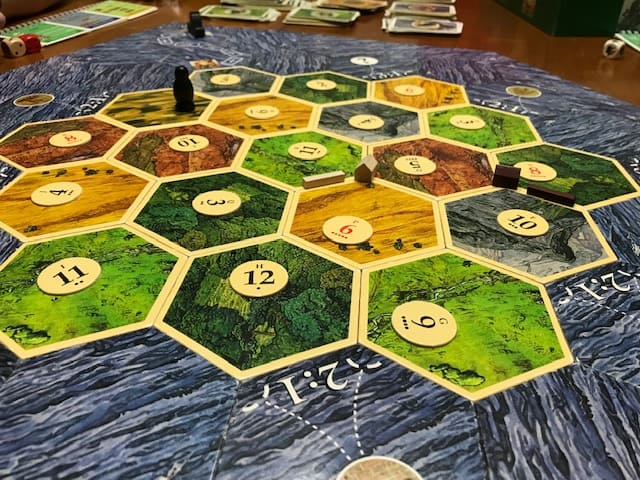
Specifics
| Players | Duration | Age | Difficulty | Type | Price | 1-10 Rating |
| 3-4 | 60-180 minutes | 10+ | Easy/medium | Bartering, resource management | $30-$35 | 8 |
Game Explanation
Catan has been around for a long time now. It was one of the first really fun, strategic games invented. In Catan, players collect resources to build roads, settlements, cities and armies. Depending on where their settlements and cities are placed, players collect the resources associated with that specific area. Players can barter with one another to obtain resources they don’t have. The player to earn 10 points during one of his or her turns wins the game.
Why it’s not boring!
Most of us have heard of and played Catan before. Acknowledging that, we couldn’t leave it off the list. It is certainly one of the best strategic board games ever created.
One of the most fun elements of Caran is the bartering aspect. Players can trade resource cards with other players in order to obtain a resource they need. The trades don’t have to necessarily be fair—whatever fair actually means here. Other players can, but don’t have to, trade with their opponents. The reason this element is so fun is that it adds some back-and-forth negotiating that most other games don’t have. Players have to smooth talk their way into getting the right deal, which can get everyone laughing while listening to it go down.
The other fun aspect to Catan is the dice and resource collecting. At the beginning of each turn, players roll a set of dice, that indicates which resources can be collected by players’ settlements or cities near them. This creates an abundance of some resources and a scarcity of others. This one game element alone creates a fun dynamic every time; but it also means that players need to get creative and find ways to collect the resources they don’t have.
Conclusion
We hope you enjoyed reading through our list of 13 strategic board games that aren’t boring! We hope you agree that the ones we’ve listed here fit that description. We only chose 13, though, and there are many more great strategic games than that. So if your list is different, we wouldn’t be all that surprised. We have a full list of all of our favorite strategic board games on our resources page here. Or you can navigate there by yourself through the menu bar; click on “Resources Page”.
